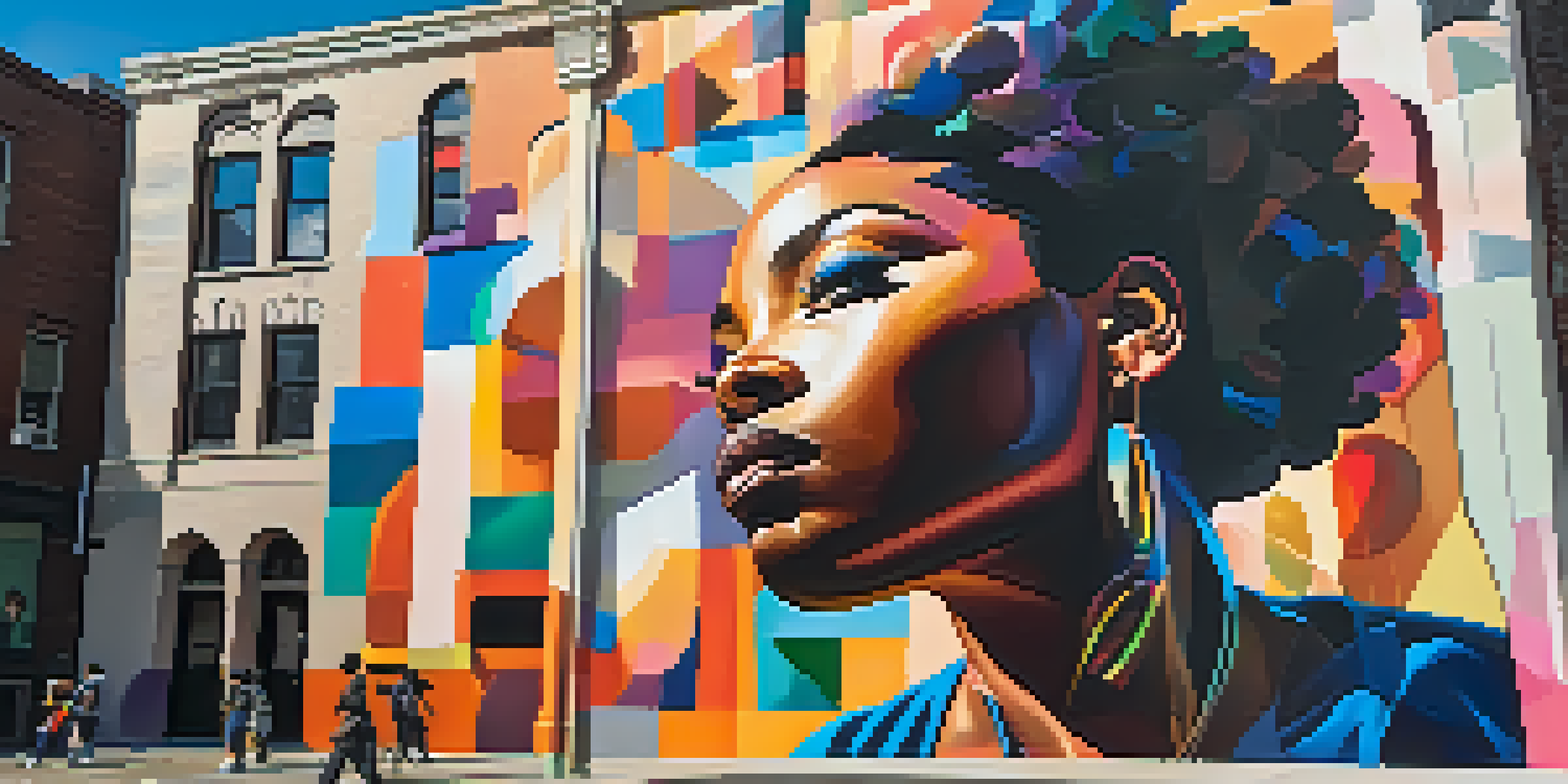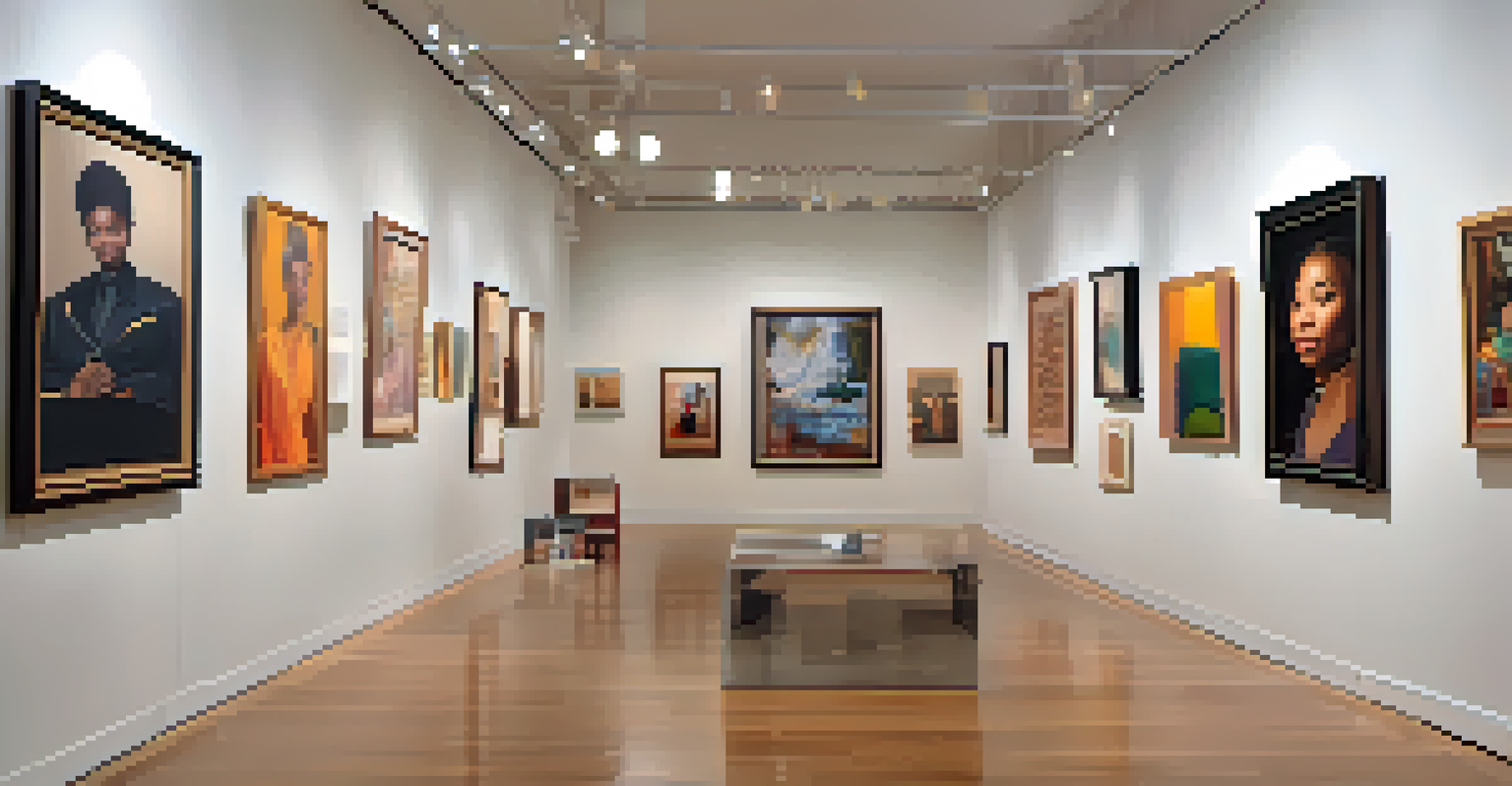Identity Politics in Contemporary Art: A Critical Analysis

Understanding Identity Politics in Art Today
Identity politics refers to the way individuals' identities—such as race, gender, sexuality, and culture—shape their perspectives and experiences. In contemporary art, this concept has gained traction as artists explore their own identities and those of marginalized communities. The result is a rich tapestry of work that challenges traditional narratives and offers diverse viewpoints.
Art is a way of expressing our identities and experiences, allowing us to challenge the norms and to foster understanding among diverse communities.
For example, artists like Kehinde Wiley and Frida Kahlo use their work to reflect on their racial and gender identities. Wiley's vibrant portraits of Black subjects draw attention to the historical absence of such figures in classical art, while Kahlo's self-portraits delve into her Mexican heritage and personal struggles. Through these expressions, identity politics becomes a lens through which art can engage with broader societal issues.
In this context, identity politics is not just about representation; it also challenges the art world’s status quo. By making their identities central to their work, artists invite viewers to reconsider preconceived notions of culture and art, fostering a more inclusive dialogue.
The Role of Representation in Contemporary Art
Representation in art plays a crucial role in shaping societal perceptions and narratives. In recent years, there has been a push for more diverse voices to be heard and seen in the art world. This shift is significant, as it allows for a broader array of experiences and stories to be shared, moving beyond the traditional Eurocentric narratives.

Take the work of artist Zanele Muholi, who uses photography to document the lives of Black LGBTQ+ individuals in South Africa. Her powerful portraits not only celebrate her subjects but also confront stereotypes and prejudices. By placing these identities in the spotlight, Muholi's work fosters empathy and understanding among viewers, prompting them to reflect on their own biases.
Identity Shapes Artistic Expression
Identity politics in art allows artists to explore and express their personal and cultural identities, fostering diverse perspectives.
Through increased representation, contemporary art becomes a platform for activism and education. It encourages conversations about race, gender, and sexuality, ultimately pushing society towards greater acceptance and understanding of diverse identities.
Challenges Faced by Artists in Identity Politics
While identity politics has empowered many artists, it also presents unique challenges. Artists may face criticism for their work being labeled as 'identity-driven’ rather than being appreciated for its artistic merit. This can lead to a feeling that their work is pigeonholed, limiting their creative expression.
Intersectionality is not just a concept; it’s a lens through which we can understand the complexities of our identities and how they influence our art and activism.
For instance, an artist who focuses on their cultural background might find it difficult to be recognized for their broader artistic capabilities. This can create pressure to continually produce work centered on specific identities, potentially stifling artistic growth. Balancing personal narrative with artistic exploration becomes a tightrope walk for many.
Moreover, the commercialization of identity politics can dilute the authenticity of the message. When corporations co-opt these themes for profit, the original intent can be lost, leading to skepticism about the motives behind such works.
Intersectionality: A Deeper Look into Identity
Intersectionality, a term coined by Kimberlé Crenshaw, refers to how various social identities overlap and interact. In contemporary art, this concept is vital as it allows artists to explore the complexities of their identities. Rather than viewing aspects such as race, gender, and class in isolation, intersectionality encourages a more nuanced understanding of how these factors contribute to individual experiences.
For example, artist Carrie Mae Weems addresses multiple layers of identity—race, gender, and class—in her work, creating a dialogue that reflects the multifaceted nature of human experience. By examining the intersections of identity, Weems' art resonates on multiple levels, inviting viewers to engage with deeper societal issues.
Social Media Empowers Artists
Platforms like Instagram enable artists to share their work and connect with audiences directly, promoting inclusivity and community.
Incorporating intersectionality in art not only enriches the narrative but also emphasizes the importance of diverse experiences. It showcases the idea that identities are not singular, but rather a complex interplay that shapes our understanding of the world.
The Impact of Social Media on Identity Politics in Art
Social media has emerged as a powerful tool for artists exploring identity politics. Platforms like Instagram and Twitter allow artists to share their work and connect with audiences directly, bypassing traditional gatekeepers of the art world. This democratization of art has led to an explosion of diverse voices and perspectives.
For instance, hashtags like #BlackArtMatters or #WomenInArt have created communities where artists can share their experiences and showcase their work. This visibility not only empowers individual artists but also fosters a sense of solidarity among marginalized groups. It's a space where conversations about identity can flourish in real time.
However, the rapid nature of social media can also be a double-edged sword. The pressure to produce content quickly may lead some artists to prioritize trends over authenticity, risking the depth and meaning of their work. Thus, while social media is a powerful platform for identity politics, it also requires careful navigation.
Art as Activism: The Political Power of Identity
Art has long been a medium for political expression, and in the realm of identity politics, it serves as a vital tool for activism. Artists often use their work to address issues such as systemic racism, gender inequality, and LGBTQ+ rights. In this way, art becomes more than just aesthetic; it transforms into a call for social change.
Consider the powerful murals created during the Black Lives Matter movement. These public artworks not only beautify urban spaces but also convey urgent messages about racial justice and equality. They engage communities in dialogue and serve as a reminder of the ongoing struggles faced by marginalized groups.
Art as a Catalyst for Change
Art serves as a powerful medium for activism, addressing social issues and inspiring dialogue around identity and justice.
Through activism, art can influence public opinion and inspire action. When artists harness their identities to speak out against injustice, they amplify their voices and those of their communities, fostering a sense of unity and purpose.
The Future of Identity Politics in Art
As society continues to evolve, so too will the discourse surrounding identity politics in art. The increasing emphasis on inclusivity suggests that future art movements will likely embrace even more diverse perspectives. This shift could lead to a richer, more complex understanding of what art can represent.
Emerging artists are already responding to this dynamic by exploring themes that challenge traditional boundaries of identity. By experimenting with new mediums and collaborations, they are pushing the envelope and enriching the narrative landscape of contemporary art.

Ultimately, the future of identity politics in art holds the potential for transformation. As artists continue to navigate their identities and societal issues, their work will likely inspire future generations to engage with art as a means of understanding and dialogue.